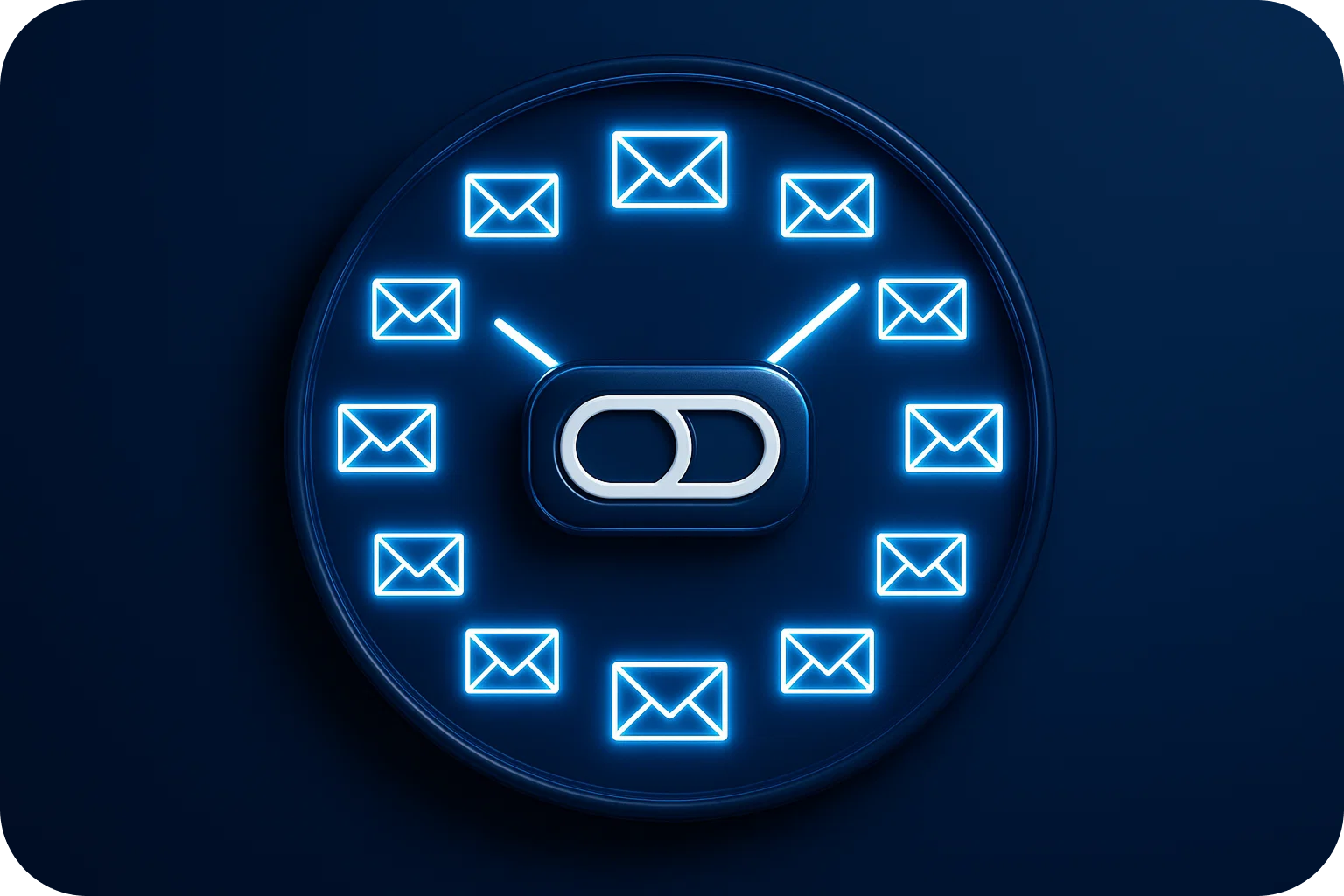The Email Frequency Formula: Finding the Sweet Spot Between Persistence and Annoyance

Cold email outreach walks a tightrope. Send too few emails, and you leave opportunities on the table. Send too many, and you risk damaging your sender reputation, triggering spam filters, and burning through your prospect list with nothing to show for it.
The question isn't whether to follow up, it's how often and for how long. This guide breaks down the data-backed sending cadence that maximizes reply rates while protecting your deliverability and maintaining genuine engagement.
Why Email Frequency Matters More Than You Think
Email frequency directly impacts three critical metrics:
Reply rates: The right cadence keeps you visible without overwhelming prospects. Studies show that 80% of sales require five follow-up touches, yet 44% of salespeople give up after one follow-up.
Deliverability: Aggressive sending patterns trigger spam filters and damage your sender reputation. Email service providers monitor sending velocity, and sudden spikes can land your domain on blocklists.
Brand perception: Every email shapes how prospects view your company. Too many touchpoints feel desperate; too few suggest you're not serious about the relationship.
The sweet spot exists where persistence meets professionalism and it's more nuanced than most marketers realize.
The Research-Backed Sending Cadence
Multiple industry studies point to a consistent pattern for optimal email follow-up sequences:
The 7-Touch Framework
The most effective cold email campaigns typically include 5-7 touchpoints spread over 2-4 weeks. Here's why this range works:
Touchpoint 1 (Day 1): Initial outreach email with clear value proposition
Touchpoint 2 (Day 3-4): First follow-up referencing the initial email
Touchpoint 3 (Day 7-8): Value-add follow-up with new insight or resource
Touchpoint 4 (Day 12-14): Different angle or case study
Touchpoint 5 (Day 18-21): Final follow-up with breakup message
Touchpoint 6-7 (Optional): Spaced 2-4 weeks later for re-engagement
This cadence respects the prospect's time while maintaining consistent visibility. The spacing allows for natural business cycles, people travel, get busy with projects, or simply need time to evaluate solutions.
Daily Sending Volume: The Technical Limits
Beyond sequence timing, your daily sending volume per inbox dramatically affects deliverability:
- New inboxes: Start with 10-20 emails per day during warm-up (3-4 weeks)
- Warmed inboxes: Scale to 40-50 emails per day maximum
- Recommended sustained volume: 20-30 emails per inbox per day
Exceeding 100 emails per inbox per day almost guarantees deliverability issues, regardless of your email quality. Email service providers flag sudden volume spikes as suspicious behavior.
Pro tip: Distribute sending across multiple inboxes (3-5 per domain) rather than overloading a single address. This approach scales your outreach while maintaining a healthy sender reputation per inbox.
The Follow-Up Timing Strategy
The intervals between follow-ups matter as much as the total number of touches.
Early-Stage Timing (Touches 1-3)
Wait 2-4 days between the first three emails. This window is short enough to maintain momentum but long enough to avoid appearing desperate. Prospects who are actively evaluating solutions will engage within this timeframe.
Mid-Stage Timing (Touches 4-5)
Extend to 5-7 days between emails. By this point, you've established a presence. Longer intervals signal confidence and give prospects breathing room. This spacing also reduces unsubscribe rates significantly.
Late-Stage Timing (Touches 6-7)
Space final touches 2-4 weeks apart. These are re-engagement attempts for prospects who showed initial interest signals (opens, clicks) but didn't reply. The extended gap resets the conversation without feeling like harassment.
Red Flags: When You're Sending Too Much
Monitor these warning signs that your frequency is damaging your campaign:
Unsubscribe rate above 0.5%: Healthy campaigns see 0.1-0.3% unsubscribes. Higher rates indicate messaging or frequency issues.
Spam complaint rate above 0.1%: Even a handful of spam complaints can trigger deliverability problems. Above 0.1% is a critical threshold.
Reply rate declining with each touch: If later emails in your sequence perform worse than earlier ones, you're likely over-communicating.
Inbox placement dropping below 95%: Use email testing tools to monitor where your emails land. Consistent spam folder placement signals reputation damage.
The Breakup Email: Your Secret Weapon
The final email in your sequence, the "breakup email" often generates the highest response rates. This message acknowledges you'll stop reaching out and gives prospects a clear exit ramp.
Example framework:
"Hi [Name], I've reached out a few times about [value proposition] but haven't heard back. I understand you're busy or this might not be a priority right now. I'll stop reaching out unless you'd like to continue the conversation. Just let me know either way."
This approach works because it:
- Removes pressure from the prospect
- Demonstrates respect for their time
- Creates urgency through implied scarcity
- Often prompts a response even if it's "not now"
Optimizing Send Time Within Your Cadence
Email timing, the specific hour and day you send, adds another layer to frequency optimization.
Best days: Tuesday, Wednesday, and Thursday consistently outperform Monday and Friday. Weekend sends typically underperform for B2B outreach.
Best times:
- 8-10 AM (local time): Catches prospects reviewing email at workday start
- 1-3 PM: Post-lunch inbox check
- 4-5 PM: End-of-day review
Critical note: Always send in the prospect's timezone. An 8 AM email in your timezone that arrives at 5 AM in theirs goes straight to the archive.
Scaling Without Sacrificing Quality
As you scale cold email operations, maintaining optimal frequency becomes more complex. Here's how to manage it:
Use Multiple Domains and Inboxes
Don't put all your sending through one domain. Distribute across:
- 3-5 inboxes per domain (recommended maximum)
- Multiple domains for high-volume campaigns
- Dedicated IP addresses for enterprise-level sending
This infrastructure approach protects your primary domain while allowing aggressive scaling.
Implement Automated Sequencing
Manual follow-up doesn't scale. Use email automation platforms that:
- Pause sequences when prospects reply
- Adjust timing based on engagement signals
- Distribute sending throughout the day
- Respect daily volume limits per inbox
Monitor Deliverability Metrics Continuously
Track these metrics weekly:
- Inbox placement rate (target: 96-98%)
- Bounce rate (target: below 2%)
- Spam complaint rate (target: below 0.1%)
- Unsubscribe rate (target: 0.1-0.3%)
Declining metrics signal the need to reduce frequency or improve email quality.
The Frequency Formula in Action
Here's a practical example of the optimal cadence for a 21-day campaign:
Week 1:
- Day 1: Initial email
- Day 4: Follow-up #1 (reference initial email)
- Day 7: Follow-up #2 (new value/insight)
Week 2:
- Day 10: Follow-up #3 (case study or different angle)
- Day 14: Follow-up #4 (social proof or testimonial)
Week 3:
- Day 21: Breakup email
Total: 6 touches over 21 days, averaging one email every 3.5 days.
This formula balances persistence with professionalism, giving prospects multiple opportunities to engage without overwhelming their inbox.
Finding Your Custom Sweet Spot
While research provides guidelines, your optimal frequency depends on:
Industry norms: Some sectors expect more frequent communication; others value restraint.
Deal size: Higher-value opportunities justify longer, more patient sequences.
Prospect seniority: C-level executives typically require fewer, more strategic touches.
Previous engagement: Prospects who opened multiple emails can handle more frequent follow-up than those showing zero engagement.
Test variations of the 7-touch framework, monitor your metrics, and adjust based on what your data reveals.
Conclusion
The email frequency formula isn't about maximizing touches; it's about maximizing meaningful engagement while protecting your sender reputation.
The sweet spot for most cold email campaigns is 5-7 touches over 2-4 weeks, with 2-7 days between emails depending on the sequence stage. Stay within 20-50 emails per inbox per day, distribute sending across multiple inboxes, and always monitor deliverability metrics.
Remember: every email you send either builds or damages your sender reputation. The right frequency formula ensures you're doing the former while generating the replies that drive revenue.
When your email infrastructure is optimized for deliverability from day one with proper warm-up, DNS configuration, and sending distribution, you can execute these cadences confidently, knowing your emails will reach the inbox where they belong.
More articles
Get started now




%201.png)




.png)
